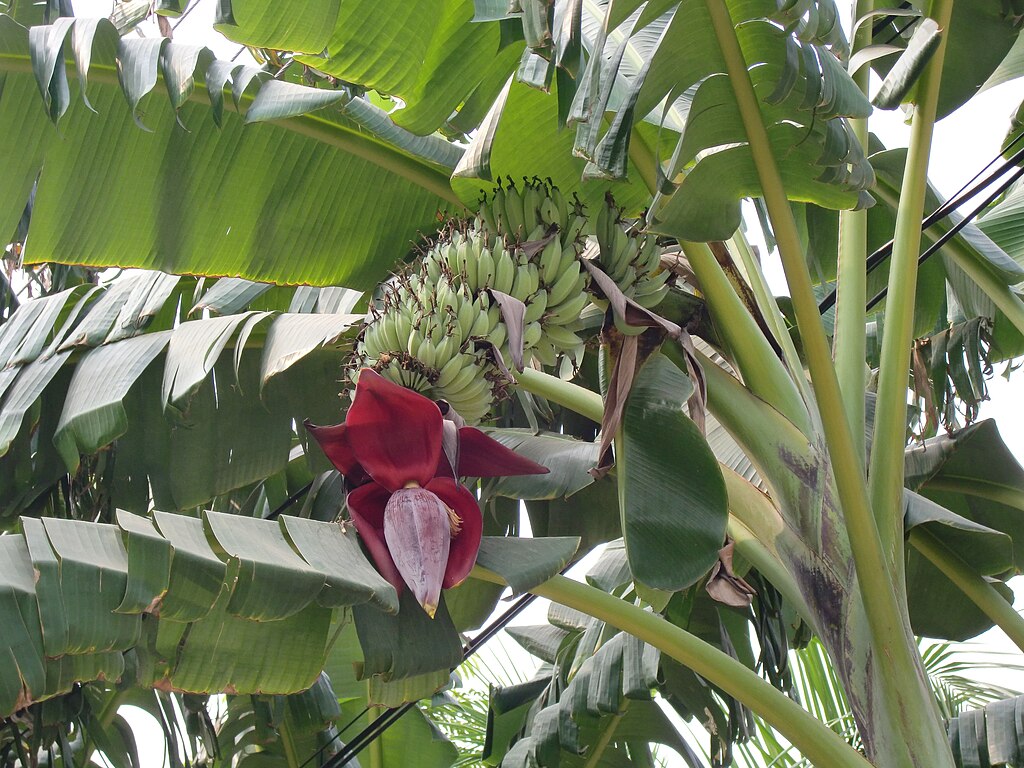Musa acuminata

|
|
Musa acuminata Common Names: Dwarf banana, Edible banana, Dessert
banana, Plantain Scientific
Classification Kingdom: Plantae Phylum: Tracheophyta Class: Liliopsida Order: Zingiberales Family: Musaceae Genus: Musa Species: M. acuminata Synonyms: Musa
cavendishii Lamb., Musa chinensis Sweet, Musa corniculata Kurz, Musa nana
Lour., Musa × sapientum var. suaveolens (Blanco) Malag., Musa rumphiana Kurz,
Musa simiarum Kurz, Musa sinensis Sagot ex Baker Morphological Description Musa acuminata, commonly
known as the edible banana, is a herbaceous perennial plant growing 2–9 m tall.
Its key features include: · Pseudostem: Formed by tightly packed leaf sheaths, 20–50 cm in diameter,
green with purple or brown markings, bearing a single terminal inflorescence · Leaves: Large, oblong, 1.5–3 m long, 30–60 cm wide, bright green,
spirally arranged, with a waxy surface and prominent midrib · Inflorescence: A pendulous spike (bunch) with purple bracts, bearing 5–20
tiers of flowers (hands), each with 10–20 hermaphrodite or male flowers · Fruit: Elongated, curved berries, 8–30 cm long, green when unripe,
yellow when ripe, seedless in cultivars, with sweet, soft pulp; wild types
contain numerous hard seeds The plant produces
suckers for vegetative reproduction, ensuring perennial growth. Flowering
occurs 6–12 months after planting, with fruit ripening in 2–4 months (Häkkinen,
2013). Distribution and Habitat Musa acuminata is native
to the Malesia region (Malaysia, Indonesia, Philippines) and mainland Indochina
(Vietnam, Thailand, Myanmar). It thrives in: · Wet Tropical Climates: At elevations of 0–1,600 m, preferring
temperatures of 22–30°C and annual rainfall of 2,000–3,000 mm · Disturbed Habitats: Found in forest edges, clearings, and
riverbanks, on well-drained, fertile soils with pH 5.5–7.0 · Global Cultivation: Naturalized in tropical Africa (e.g.,
Nigeria, Uganda), Latin America, and the Caribbean due to extensive cultivation
since prehistoric times Ethnopharmacology Musa acuminata is widely
used in traditional medicine across Africa, Asia, and Latin America, with ethnopharmacological
studies validating several applications: · Antidiabetic Activity: Ethanol leaf extracts (200 mg/kg) reduce
blood glucose by 30–40% in streptozotocin-induced diabetic rats, attributed to
flavonoids and phenolic compounds inhibiting α-glucosidase (IC₅₀ 15.2 μg/mL)
(Sasikumar et al., 2012). · Antioxidant Properties: Fruit peel is use for oxidative
stress-related disorders). · Anti-inflammatory Effects: Stem juice (100 mg/kg) reduces paw edema
in carrageenan-induced inflammation in mice by 45%, attributed to alkaloids and
glycosides, supporting use for insect bites and swelling (Kumar et al., 2013). · Gastroprotective Effects: is use for gastrointestinal issues. · Antimicrobial Activity: Leaf extracts inhibit Escherichia coli and
Staphylococcus aureus (MIC 50–100 μg/mL), due to terpenoids and flavonoids,
supporting use for infections (Fagbemi et al., 2009). ⚠ Toxicity Profile: Musa acuminata is generally safe for consumption, with no
significant toxicity reported in doses up to 2,000 mg/kg in rats (NOAEL).
However, its latex-like sap contains chitinases, which may trigger allergic
reactions in individuals with latex-fruit syndrome, causing itching or
anaphylaxis. Unripe fruits high in tannins may cause mild gastrointestinal
discomfort if overconsumed. Avoid use in patients with potassium-related
disorders (e.g., hyperkalemia) due to high fruit potassium content (400
mg/100g). Consult a practitioner for medicinal use, especially during pregnancy
or with allergies (Sumner, 2009). Additional Uses · Culinary: Fruits are consumed fresh, dried, or cooked (e.g., fried,
boiled), with 25–30% carbohydrates and 1–2% protein, used in desserts,
smoothies, and savory dishes (Ploetz et al., 2007). · Economic: A global trade value of US$14 billion annually, supporting
millions of farmers in countries like Nigeria and Uganda, with Cavendish
cultivars dominating exports (FAO, 2023). · Industrial: Leaves are used as biodegradable plates and wrapping
materials; pseudostems yield fibers for textiles and paper, with 2–3% fiber
content (Mohapatra et al., 2010). · Ecological: Provides shade in agroforestry systems, stabilizes soil on
slopes, and supports pollinators (bats, bees) and frugivorous animals,
enhancing biodiversity (Häkkinen, 2013). · Cultural: Leaves and fruits are used in rituals and festivals in
Africa and Asia, symbolizing fertility and prosperity (Kew Science, n.d.). References
External Links More Pictures |
|
| Compounds of Musa acuminata | |
| References |